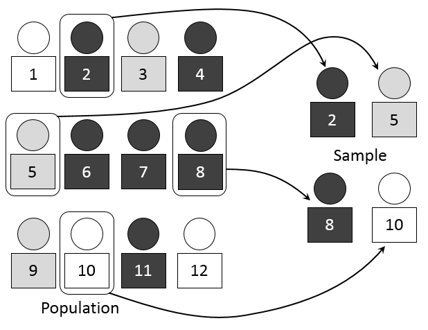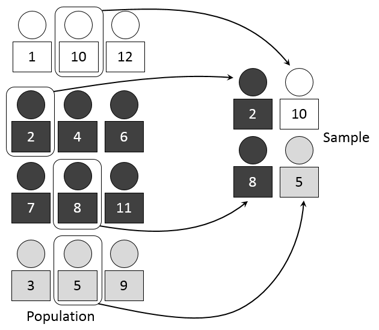With this post, we'll conclude our series on sampling techniques. Today we’re going to talk about the snowball sampling method.
Snowball sampling is a nonrandom sampling method in which the individuals selected to be studied recruit new participants from among their circle of acquaintances. The word “snowball” comes from just that idea: in the same way that a snowball becomes bigger and bigger as it rolls down a hill, this method enables the sample size to grow as the individuals selected to participate invite people they know to join.

Snowball sampling is often used to access low-incidence populations and individuals who are difficult for researchers to connect with. For studies that hope to study a very specific group, such as stamp collectors, obtaining a sample through collectors’ networks of friends and acquaintances can prove much more effective than selecting individuals in a strictly random fashion, since, in the latter case, the overwhelming majority of candidates will be dismissed. In theory, it is highly likely that a stamp collector will know other stamp collectors, which makes this an effective method of sampling a group that a researcher would otherwise have difficulty accessing.
Naturally enough, the snowball method works especially well when the distinctive characteristic of the population we want to study tends to form groups for social purposes. This is more common than you might initially think. Collectors, athletes and lovers of certain musical genres are the obvious candidates. But other groups work equally well: patients with a rare illness are one example—these individuals’ personal circumstance make it more likely that they will get in touch with other people in the same situation (through medical appointments, associations, etc.).
Process
The process of creating a sample using the snowball method is based on using certain initial individuals’ social network to access a group. The process could be divided into the following steps:
- Defining a participation program and describing the process by which an individual invites or refers others to participate.
- Identifying groups or organizations that could provide access to certain initial individuals who fit the characteristic of the study.
- Obtaining initial contacts and asking them to participate.. This part is similar to conventional sampling methods, but with the intention of obtaining a reduced sample size.
- Asking participants for access to other contacts, once the interview is complete.
- Ensuring diversity of contacts by properly selecting the initial individuals and encouraging them to recommend the study to more than just their closest acquaintances.
TYPES OF SNOWBALL SAMPLING

There are basically two kinds of snowball sampling:
- Linear sampling: Each individual participant recommends exactly one other participant, so that the sample grows at a linear pace.
- Exponential sampling: Every participant invites two or more individuals, so that the more people participate in the study, the faster it will grow.
ADVANTAGES AND DISADVANTAGES
This method’s main advantages are that:
- It makes it possible to sample populations that are otherwise difficult to access.
- It is an affordable and simple process.
- It requires minimal planning and human resources: the subjects themselves do the footwork.
As for the disadvantages:
- There is a lack of control over how the sample is made, since this responsibility is in the hands of the participants themselves and their own criteria for selecting new individuals.
- Like any nonrandom sampling method, snowball sampling does not guarantee representation and there is no way of knowing how precise it really is.
- This method is particularly susceptible to sampling bias. Since participants are chosen by individuals who have already been selected, it is possible that all of the participants will share certain characteristics or traits, regardless of the trait the study hopes to examine. Consequently, the sampling will access only one subgroup of the population to be studied. This is especially liable to be the case if the selection of initial individuals is not sufficiently diverse.
- Unchecked sample size: this method prevents us from precisely determining our desired sample size ahead of time.
OtHER CONSIDERATIONS
There is no doubt that the main problem with snowball sampling is the “community bias” risk: we access a subgroup of individuals within our target and the recruitment of new members does not branch out from that subgroup. The only way to sidestep this obstacle is to properly select the initial individuals, which ensures that any subgroup is accessible in the initial individuals’ network of contacts.
It’s worth pointing out that this is often the only method possible when we are targeting reduced groups for which sampling frames cannot be obtained. This is why many researchers work hard to perfect this method, in order to correct its biases. Specifically, one of the most promising methods currently being worked with is Respondent Driven Sampling, a system that attempts to correct biases that may have been introduced through the selection of individuals by imposing a mathematical model.
And just like that, we’ve come to the conclusion of this series of posts on sampling methods. We hope that it has been useful and, as always, we’ll be happy to answer any questions in the comments section. Until next time!
TABLE OF CONTENTS: Series on sampling
- Sampling: What it is and why it works
- Random and non-random sampling
- Random sampling: Simple random sampling
- Random sampling: Stratified sampling
- Random sampling: Systematic sampling
- Random sampling: Cluster sampling
- Non-random sampling: Availability sampling
- Non-random sampling: Quota sampling
- Non-random sampling: Snowball sampling






